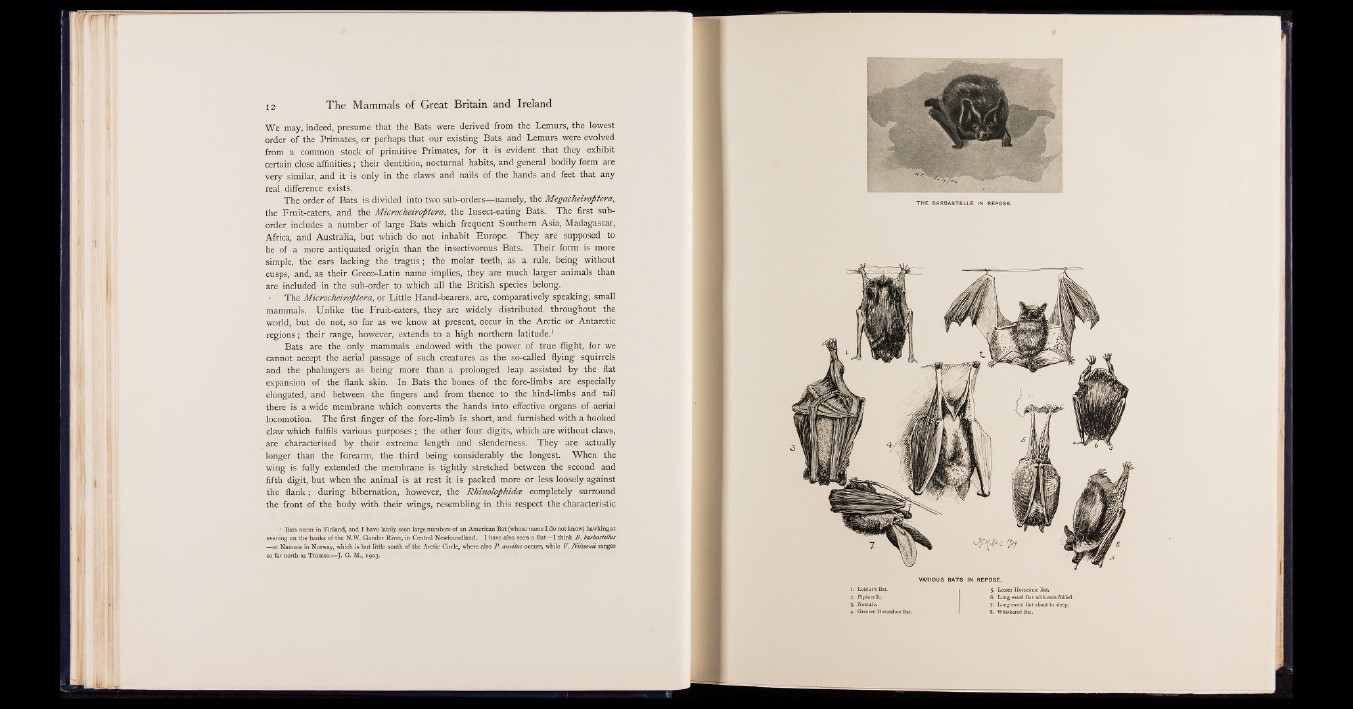
We may, indeed, presume that the Bats were derived from the Lemurs, the lowest
order of the Primates, or perhaps that our existing Bats and Lemurs were evolved
from a common stock of primitive Primates, for it is evident that they exhibit
certain close affinities; their dentition, nocturnal habits, and general bodily form are
very similar, and it is only in the claws and nails of the hands and feet that any
real difference exists.
The order of Bats is divided into two sub-orders— namely, the Megacheiroptera,
the Fruit-eaters, and the Microcheiroptera, the Insect-eating Bats. The first suborder
includes a number of large Bats which frequent Southern Asia, Madagascar,
Africa, and Australia, but which do not inhabit Europe. They are supposed to
be of a more antiquated origin than the insectivorous Bats. Their form is more
simple, the ears lacking the tragus; the molar teeth, as a rule, being without
cusps, and, as their Greco-Latin name implies, they are much larger animals than
are included in the sub-order to which all the British species belong.
• The Microcheiroptera, or Little Hand-bearers, are, comparatively speaking, small
mammals. Unlike the Fruit-eaters, they are widely distributed throughout the
world, but do not, so far as we know at present, occur in the Arctic or Antarctic
regions; their range, however, extends to a high northern latitude.1
Bats are the only mammals endowed with the power of true flight, for we
cannot accept the aerial passage of such creatures as the so-called flying squirrels
and the phalangers as being more than a prolonged leap assisted by the flat
expansion of the flank skin. In Bats the bones of the fore-limbs are especially
elongated, and between the fingers and from thence to the hind-limbs and tail
there is a wide membrane which converts the hands into effective organs of aerial
locomotion. The first finger of the fore-limb is short, and furnished with a hooked
claw which fulfils various purposes ; the other four digits, which are without claws,
are characterised by their extreme length and slenderness. They are actually
longer than the forearm, the third being considerably the longest. When the
wing is fully extended the membrane is tightly stretched between the second and
fifth digit, but when the animal is at rest it is packed more or less loosely against
the flank; during hibernation, however, the Rhinolophidce completely surround
the front of the body with their wings, resembling in this respect the characteristic
' Bats occur in Finland, and I have lately seen large numbers of an American Bat (whose name I do not know) hawking at
evening on the banks of the N.W. Gander River, in Central Newfoundland. I have also seen a Bat—I think B . barbastellus
—at Namsos in Norway, which is but little south of the Arctic Circle, where also P . auritus occurs, while V NHssottii ranges
so far north as Tromso.— J. G. M., 1903.